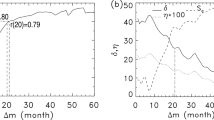Abstract
The growth rate of solar activity in the early phase of a solar cycle has been known to be well correlated with the subsequent amplitude (solar maximum). It provides very useful information for a new solar cycle as its variation reflects the temporal evolution of the dynamic process of solar magnetic activities from the initial phase to the peak phase of the cycle. The correlation coefficient between the solar maximum (R max) and the rising rate (β a) at Δm months after the solar minimum (R min) is studied and shown to increase as the cycle progresses with an inflection point (r = 0.83) at about Δm = 20 months. The prediction error of R max based on β a is found within estimation at the 90% level of confidence and the relative prediction error will be less than 20% when Δm ⩾ 20. From the above relationship, the current cycle (24) is preliminarily predicted to peak around October, 2013 with a size of R max = 84 ± 33 at the 90% level of confidence.
Similar content being viewed by others
References
Waldmeier M. Über die struktur der sonnenflecken. Astron Mitt Zrich, 1939, 14: 439–450
Hathaway D H, Wilson R M, Reichmann E J. Group sunspot numbers: Sunspot cycle characteristics. Sol Phys, 2002, 211(1): 357–370
Du Z L, Wang H N, Zhang L Y. Correlation function analysis between sunspot cycle amplitudes and rise times. Sol Phys, 2009, 255(1): 179–185
Cameron R, Schüssler M. A robust correlation between growth rate and amplitude of solar cycles: Consequences for prediction methods. Astrophys J, 2008, 685(2): 1291–1296
Du Z L, Li R, Wang H N. The predictive power of Ohl’s precursor method. Astron J, 2009, 138(6): 1998–2001
Du Z L, Wang H N. Is a higher correlation necessary for a more accurate prediction? Sci China-Phys Mech Astron, 2011, 54(1): 172–175
Du Z L. The relationship between prediction accuracy and correlation coefficient. Sol Phys, 2011, 270(1): 407–416
Du Z L. The shape of solar cycle described by a modified gaussian function. Sol Phys, 2011, 273(1): 231–253
Kane R P. Size of the coming solar cycle 24 based on Ohl’s precursor method, final estimate. Ann Geophys, 2010, 28(7): 1463–1466
Pesnell WD. Predictions of solar cycle 24. Sol Phys, 2008, 252(1): 209–220
Messerotti M, Zuccarello F, Guglielmino S L, et al. Solar weather event modelling and prediction. Space Sci Rev, 2009, 147(3): 121–185
Du Z L. The solar cycle: A new prediction technique based on logarithmic values. Astrophys Space Sci, 2011, doi: 10.1007/s10509-011-0906-4
Wang J L, Miao J, Liu S Q, et al. Prediction of the smoothed monthly mean sunspot numbers for solar cycle 24. Sci China Ser G-Phys Mech Astron, 2008, 51(12): 1938–1946
Wang J L, Gong J C, Liu S Q, et al. The prediction of maximum amplitudes of solar cycles and the maximum amplitude of solar cycle 24. Chin J Astron Astrophys, 2002, 2(6): 557–562
Wang J L, Zong W G, Le G M, et al. Predicting the start and maximum amplitude of solar cycle 24 using similar phases and a cycle grouping. Res Astron Astrophys, 2009, 9(2): 133–136
Le G M. Wavelet analysis of the Schwabe cycle properties in solar activity. Chin J Astron Astrophys, 2004, 4(6): 578–582
Li K J. What does the Sun tell and hint now? Res Astron Astrophys, 2009, 9(9): 959–965
Ohl A I. A preliminary forecast of some parameters of cycle No. 21 of the solar activity. Solnice Danie, 1976, 9: 73–75
Layden A C, Fox P A, Howard J M, et al. Dynamo-based scheme for forecasting the magnitude of solar activity cycles. Sol Phys, 1991, 132: 1–40
Thompson R J. A technique for predicting the amplitude of the solar cycle. Sol Phys, 1993, 148(2): 383–388
Shastri S. An estimate for the size of cycle 23 using multivariate relationships. Sol Phys, 1998, 180(1): 499–504
Schüssler M. Are solar cycles predictable? Astron Nachr, 2007, 328(10): 1087–1091
Cameron R, Schüssler M. Solar cycle prediction using precursors and flux transport models. Astrophys J, 2007, 659(1): 801–811
Du Z L, Wang H N, Zhang L Y. A running average method for predicting the size and length of a solar cycle. Chin J Astron Astrophys, 2008, 8(4): 477–488
Du Z L, Wang H N. Does a low solar cycle minimum hint at a weak upcoming cycle? Res Astron Astrophys, 2010, 10(10): 950–955
Svalgaard L, Cliver E W, Kamide Y. Sunspot cycle 24: Smallest cycle in 100 years? Geophys Res Lett, 2005, 32(1): L01104
Schatten K H. Fair space weather for solar cycle 24. Geophys Res Lett, 2005, 32(21): L21106
Li K J, Feng W, Liang H F, et al. A brief review on the presentation of cycle 24, the first integrated solar cycle in the new millennium. Ann Geophys, 2011, 29(2): 341–348
Li K J, Feng W, Liang H F. The abnormal 24th solar cycle—the first complete solar cycle of the new millennium (in Chinese). Sci Sin Phys Mech Astron, 2010, 40(10): 1293–1301
Choudhuri A R, Chatterjee P, Jiang J. Predicting solar cycle 24 with a solar dynamo model. Phys Rev Lett, 2007, 98(13): 131103
Jiang J, Chatterjee P, Choudhuri A R. Solar activity forecast with a dynamo model. Mon Not Roy Astron Soc, 2007, 381(4): 1527–1542
Dikpati M, Gilman P A. Simulating and predicting solar cycles using a flux-transport dynamo. Astrophys J, 2006, 649(1): 498–514
Li K J, Gao P X, Su T W. Estimating the size and timing of the maximum amplitude of solar cycle 24. Chin J Astron Astrophys, 2005, 5(5): 539–545
Du Z L, Wang H N. The prediction method of similar cycles. Res Astron Astrophys, 2011, 11(12): 1482–1492
Wang Y M, Sheeley N R. Understanding the geomagnetic precursor of the solar cycle. Astrophys J, 2009, 694(1): L11–L15
Hiremath KM. Prediction of solar cycle 24 and beyond. Astrophys Space Sci, 2008, 314(1–3): 45–49
Rigozo N R, Souza E M P, Evangelista H, et al. Prediction of sunspot number amplitude and solar cycle length for cycles 24 and 25. J Atmos Sol Terr Phys, 2011, 73(11–12): 1294–1299
Dabas R S, Sharma K, Das R M, et al. A prediction of solar cycle 24 using a modified precursor method. Sol Phys, 2008, 250(1): 171–181
Tlatov A G. Some notes concerning the prediction of the amplitude of the solar activity cycles. Astrophys Space Sci, 2009, 323(3): 221–224
Hathaway D H, Wilson R M. Geomagnetic activity indicates large amplitude for sunspot cycle 24. Geophys Res Lett, 2006, 33(18): L18101
Author information
Authors and Affiliations
Corresponding author
Rights and permissions
About this article
Cite this article
Du, Z., Wang, H. Predicting the solar maximum with the rising rate. Sci. China Phys. Mech. Astron. 55, 365–370 (2012). https://doi.org/10.1007/s11433-011-4612-6
Received:
Accepted:
Published:
Issue Date:
DOI: https://doi.org/10.1007/s11433-011-4612-6




